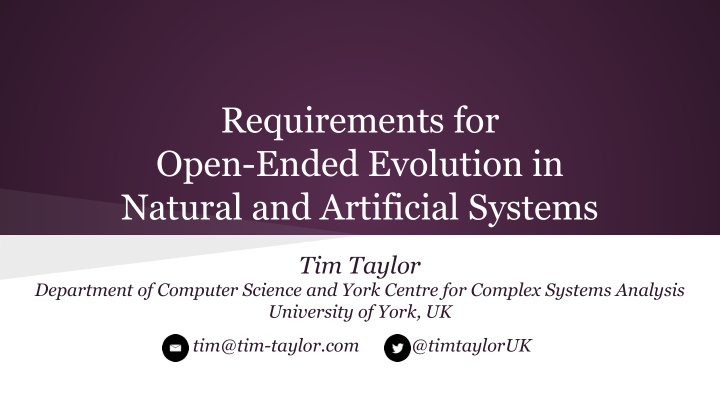



Requirements for Open-Ended Evolution in Natural and Artificial Systems Tim Taylor Department of Computer Science and York Centre for Complex Systems Analysis University of York, UK tim@tim-taylor.com @timtaylorUK
(Informal) working definitions Open-ended evolution is: “evolutionary dynamics in which new, surprising, and sometimes more complex organisms and interactions continue to appear” even more informally: “a system where the continued evolution of novel forms is so interesting that the researcher is unwilling to press the ‘off’ switch”
OEE vs Evolvability Evolvability ● the ability of a specific genotype-phenotype mapping to increase the proportion of favourable mutations Open-Endedness ● drive for on-going evolution co-evolution ○ niche construction ○ utilizing the complexity of the environment ○ new forms of organisation ○
Many concepts are relevant to OEE!
An initial attempt at organising concepts...
Five fundamental requirements #1 Robustly reproductive individuals ● ( Here we are talking about robustness of ecological individuals, not populations ) ● Von Neumann’s self-reproducing cellular automata are not robust ● Tierra and Avida hard-wire robustness into the system this limits evolutionary potential ○ ● What are the appropriate ways to achieve robustness in artificial life systems?
Five fundamental requirements #2 Individuals capable of producing more complex offspring ● Could be achieved in (at least) two different ways: ○ A single individual is capable of producing offspring of greater complexity than itself e.g. Von Neumann’s solution (interpretted/uninterpretted structure) ■ ■ Implemented in Tierra, but interpretor is hard-coded and not evolvable ■ Also wish to evolve other aspects (e.g. genetic transmission, organisation of genome, mutation rates, etc): “evolution of evolution” Two or more individuals are jointly capable of producing offspring ○ of greater complexity than any one of its parents ■ Horizontal gene transfer, symbiogenesis. Much less explored in ALife systems
Five fundamental requirements #3 Mutational pathways to other viable individuals ● Rensch’s (1947) “improvements allowing further improvements” ● Much relevant work in recent literature Neutral networks, genotype networks ○ ○ Evolvable G-P mappings, facilitated variation ○ Evolution of modular / loosely coupled / nearly decomposable systems ○ Extradimensional bypasses, exaptation, multimodal bridges
Five fundamental requirements #4 A medium allowing the possible existence of a practically unlimited diversity of individuals and interactions ● Complex environments, “toy bricks”, “sorta” evolution ● What features of the environment are required for: ○ Not just evolving increased computational and information processing capabilities, but also: Evolving new sensors and effectors (new inputs and outputs), an ○ important part of biological OEE ○ And new organisations (major transitions)
Five fundamental requirements #5 Drive for continued evolution ● (Natural) selection pressure from limited resources, competition, etc., creating an adaptive landscape ● Continued selection pressure through changing adaptive landscape ○ Individuals being part of environment experienced by others leading to co-evolution, niche construction, ecosystem engineering, etc. ■ ■ Connectedness: food webs, transmission of forces, signals: “just being there” ○ Also change through diffusion of species to new environments ■ (e.g. allopatric speciation)
Five fundamental requirements 1. Robustly reproductive individuals 2. Individuals capable of producing more complex offspring 3. Mutational pathways to other viable individuals 4. A medium allowing the possible existence of a practically unlimited diversity of individuals and interactions 5. Drive for continued evolution Paper available at http://www.tim-taylor.com/ tim@tim-taylor.com @timtaylorUK
Recommend
More recommend